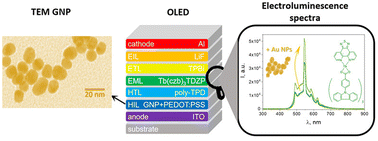A 50% increase in the terbium-based OLED luminance through reducing the excited-state lifetime due to the introduction of gold nanoparticles†
Abstract
An increase in the efficiency for a terbium-based OLED was achieved by introducing gold nanoparticles into the PEDOT:PSS hole injection layer and was mainly due to the improvement in carrier injection and the reduction of the excited-state lifetime. The introduction of plasmon-resonant gold nanoparticles resulted in a 50% increase in the Tb(czb)3TDZP luminance, which reached 480 cd m−2 and is the highest result for OLEDs based on aromatic carboxylates.



 Please wait while we load your content...
Please wait while we load your content...